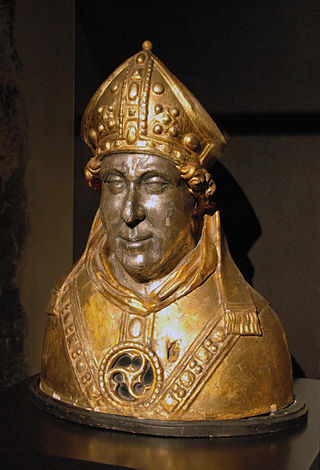
The Archbishop of Cologne is an archbishop governing the Archdiocese of Cologne of the Catholic Church in western North Rhine-Westphalia and is also a historical state in the Rhine holding the birthplace of Beethoven and northern Rhineland-Palatinate in Germany and was ex officio one of the Prince-electors of the Holy Roman Empire, the Elector of Cologne, from 1356 to 1801.

Count Engelbert II of Berg, also known as Saint Engelbert, Engelbert of Cologne, Engelbert I, Archbishop of Cologne or Engelbert I of Berg, Archbishop of Cologne was archbishop of Cologne and a saint; he was notoriously murdered by a member of his own family.

Count Frederick of Isenberg was a German noble, the younger son of Arnold of Altena. Before the split between Arnold of Altena-Isenberg the eldest and his brother Friedrich Altena-Mark the younger son of Everhard von Berg-Altena. His family castle was the Isenberg near Hattingen, Germany.
Adolf of Altena, Adolf of Berg or Adolf of Cologne, was Archbishop of Cologne from 1193 to 1205.

Henry IV was the duke of Limburg and count of Berg from 1226 to his death. He was the son of Waleran III, count of Luxembourg and duke of Limburg, and Cunigunda, daughter of Frederick I, Duke of Lorraine.
Adolf III of Berg was count of Berg from 1093 until 1132, and count of Hövel from 1090 until 1106, and Vogt of Werden. He was the son of Adolf II of Berg-Hövel, count of Berg, and Adelaide of Lauffen.

Adolf IV of Berg count of Berg from 1132 until 1160 and of Altena, son of Adolf III of Berg count of Berg and Hövel. He married (1st) Adelheid von Arnsberg, a daughter of Heinrich count von Rietberg; then (2nd) Irmgard (?) von Schwarzenberg, a daughter of Engelbert von Schwarzenberg.

Arnold of Altena, count of Altena, count of Isenberg and Hövel, Vogt of Werden (1166–1209) was a son of Eberhard IV of Berg. He inherited the north-western territorium of Altena, and became 1st count of Isenberg in 1200. He married Mathilde countess of Cleve daughter of Dietrich III, Count of Cleves and Adelaide of Sulzbach (+12.2.1189). Mathilde's brother was count Diederick IV of Cleve (+1193) who married in 1182 Mechteld (Margaret) of Holland.
Heinrich I von Müllenark (1190–1238) was the Archbishop of Cologne within the Holy Roman Empire from 1225 until 1237.
Bruno II of Berg was the Archbishop of Cologne from 1131 until 1137. Bruno II of Berg was a son of Count Adolf III of Berg. In 1119 he was mentioned as a Provost in Cologne, and he became the provost of St. Gereon in Cologne in 1127. In 1130 he was elected the Archbishop of Trier, but refused.
Friedrich II of Berg, was Archbishop of Cologne from 1156 until his death in 1158.

The House of Limburg-Stirum, which adopted its name in the 12th century from the immediate county of Limburg an der Lenne in what is now Germany, is one of the oldest families in Europe. It is the eldest and only surviving branch of the House of Berg, which was among the most powerful dynasties in the region of the lower Rhine during the Middle Ages. Some historians link them to an even older dynasty, the Ezzonen, going back to the 9th century.

Altenberg Abbey is a former Cistercian monastery in Altenberg, now a part of the municipality of Odenthal in the Bergisches Land, North Rhine-Westphalia, Germany.
Bruno IV von Sayn was the archbishop of Cologne from 1205 until his death.
Lothar von Hochstaden was Bishop of Liège and archchancellor.

The Altenberger Dom is the former abbey church of Altenberg Abbey which was built from 1259 in Gothic style by Cistercians. Listed as a cultural heritage, it is located in Altenberg, now part of Odenthal in the Rheinisch-Bergischer Kreis, North Rhine-Westphalia, Germany. Until 1511, the church was the burial site of counts and dukes of Berg and the dukes of Jülich-Berg.
Adelaide of Lauffen was a German noblewoman.

The house of Limburg Hohenlimburg took its name in the 12th century from the county of Limburg on the river Lenne in today's Germany. After Diederick of Isenberg had claimed part of the former property of his father Frederik of Isenberg with the help of uncle Duke Hendrik of Limburg, he built the Hohenlimburg castle on the river Lenne. His youngest son Everhart succeeded him in the county at the end of the 13th century and is the ancestor of the family branch of the counts of Limburg Hohenlimburg and Broich. His eldest brother Johan (1247-1277), died at the age of thirty, left three children. The Counts of Limburg Hohenlimburg and Broich were not only a count by name (title), but actually ruled the county of Limburg-Lenne until the first quarter of the 16th century. The last count Johan (1464-1511) who had no descendants of his own. None of his only two male relatives, cousins Diederick and Adolf of Limburg, sons of his former godfather Johan of Limburg (1421-1472), had inheritance rights, as explained below. To prevent the family of his former wife Von Neuenahr from taking the county, Count Johan adopted his cousin Irmgard of Sayn at her marriage to Winrich of Daun. She and her husband inherited the county.









